Our Health Library information does not replace the advice of a doctor. Please be advised that this information is made available to assist our patients to learn more about their health. Our providers may not see and/or treat all topics found herein.
Topic Contents
Healthy Eating Basics: Cooking
Overview
Knowing a few simple cooking methods can help with healthy eating. And trying the methods for yourself at home can help you discover more foods that you may really like. Did you know that changing the cooking method can give food a completely different flavor and texture? Use these tips for cooking basics and to find your favorite way to cook.
Sauté for fast flavor.
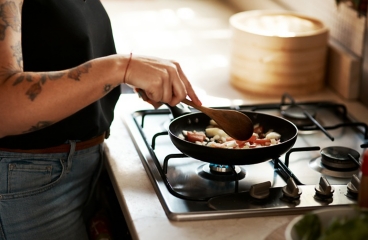
Sautéing may sound fancy, but it just means you use a hot pan and oil to cook food quickly.
- How to sauté. Heat a large pan with 1 tablespoon of vegetable oil. To check if the pan is hot enough, add a piece of chopped food. Does it sizzle immediately? This is a sure sign that your pan is hot and ready. Add your food as a single layer in the pan. Stir every couple minutes so that all the pieces brown on all sides.
- What to sauté. Try it for vegetables like spinach, mushrooms, asparagus, bell peppers, onions, and zucchini. Protein foods— like eggs, chopped chicken, and tofu—work well too.
Roast for deep flavor and color.
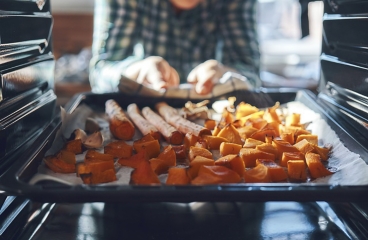
Roasting browns the surface of food with the high heat of an oven.
- How to roast. Preheat the oven to 425 degrees. Put your food in a bowl. Drizzle it with vegetable oil, and stir until everything is coated. Spread the food out onto a baking sheet so that it's all in one layer with space between each piece. Sprinkle with any herbs and spices you like. Put the baking sheet on the middle rack of the hot oven. Check it after 15 minutes, and stir. Add more time until the food is cooked through, golden brown, and maybe even a little crispy on the edges.
- What to roast. Try vegetables like broccoli, cauliflower, brussels sprouts, potatoes, carrots, asparagus, and butternut squash. Proteins—like chicken, beef, tofu, and tempeh—do well with roasting too.
Steam to keep food moist.
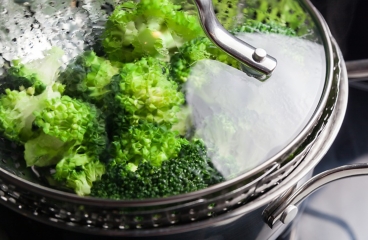
Steaming cooks food over a pan of boiling water. The food doesn't touch the water. Instead, it's cooked by the steam coming off the hot water. Serve steamed vegetables as is, or add seasonings after cooking. You can't go wrong with chopped fresh herbs, olive oil, or a squeeze of lemon juice for veggies and a dusting of cinnamon for fruits.
- How to steam on the stove. In a pot, add an inch or two of water. Set a steamer basket inside. Make sure the water doesn't touch the steamer basket. Cover the pot with the steamer basket inside, and bring the water to a boil. Add food to the steamer basket. Cover the pot, and cook until your food is fork tender and the veggies are still bright in color. Steaming on the stove top can take 5 to 15 minutes, depending on the size and texture of your food.
- How to steam in the microwave. Put food in a microwave-safe bowl. Add 1 to 3 tablespoons of water, and cover the bowl with a microwave-safe plate. Cook on high starting with 1 minute. Steaming in the microwave can take 1 to 10 minutes, depending on the size and texture of your food and the power of your microwave.
- What to steam. Options include vegetables like potatoes, sweet potatoes, asparagus, beets, broccoli, carrots, and peas. Fish can be steamed until it flakes apart with a fork. Or try it with fruits like apples and pears.
Avoid overcooking.
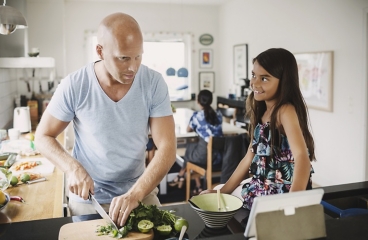
Overcooking changes the color and texture of your food—and not in a good way. Broccoli turns a dull green, and rice can turn to mush. Try these tips to avoid overcooking.
- Set a timer. It can be easy to lose track of time, especially if you're doing more than one thing in the kitchen. Using a timer can help you stay on track. Set it for about 5 minutes before you think your food will be done. You can always check your food and add more time if needed.
- Find a recipe. Recipes can help you understand cooking times for different foods. Find recipes online, or check out a cookbook from the library.
Remember: Raw works too.
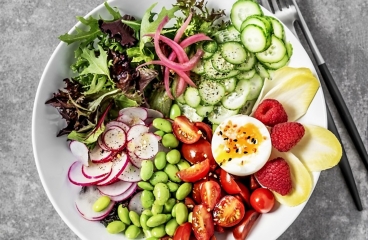
You can also serve many vegetables and fruits raw. You can chop and serve, or bite right in. Try it with carrots, cucumbers, bell peppers, radishes, and turnips. Or try apples, bananas, oranges, mangoes, pears, and strawberries. You can also try changing up your chop. Try slicing carrots and cucumbers into spears, bell peppers into rings, and oranges into half circles.
Related Information
Credits
Current as of: October 7, 2024
Author: Ignite Healthwise, LLC Staff
Clinical Review Board
All Ignite Healthwise, LLC education is reviewed by a team that includes physicians, nurses, advanced practitioners, registered dieticians, and other healthcare professionals.
Current as of: October 7, 2024
Author: Ignite Healthwise, LLC Staff
Clinical Review Board
All Ignite Healthwise, LLC education is reviewed by a team that includes physicians, nurses, advanced practitioners, registered dieticians, and other healthcare professionals.
This information does not replace the advice of a doctor. Ignite Healthwise, LLC disclaims any warranty or liability for your use of this information. Your use of this information means that you agree to the Terms of Use and Privacy Policy. Learn how we develop our content.
To learn more about Ignite Healthwise, LLC, visit webmdignite.com.
© 2024-2025 Ignite Healthwise, LLC.





